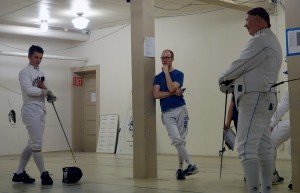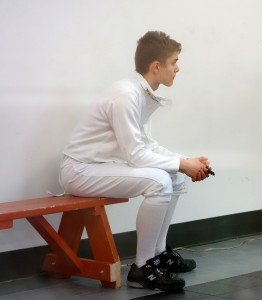By Ian Ferguson
When Blaine resident Alexander “AJ” Nelson tried baseball and other team sports, he found that success was nearly impossible to achieve if other players didn’t put in the effort. In part, that’s what led him to fencing, a sport he began five years ago at the age of 11.
“I practice with a group of athletes, and we support each other in tournaments, but success in fencing is based on how you perform as an individual,” Nelson said.
As a history buff, Nelson was attracted to fencing for other reasons as well.
“It’s an old sport with a lot of history, and history is my favorite subject,” he said.
With a keen intellect and the athletic reflexes to parry and attack on an elite level, it seems Nelson has found his niche. Nelson placed first in the 17-and-under class in regional qualifiers November 23, earning a place at the national Junior Olympic Fencing Championships. The championships will be held in Richmond, Virginia in February.
Fencing is the competitive martial art of fighting with swords, or blades. Nelson competes in épée, one of three weapon categories in fencing. The other two categories are foil and saber.
In all three categories, striking your opponent with your sword before they strike you scores points. Foil fencing, the most popular style, uses the lightest blade. The valid striking area is limited to the opponent’s torso, and the strike must be done with the tip of the blade. “Right of way” points are awarded based on who initiated the attack.
In épée, the entire body is fair game, including hands, feet and head, and there are no “right of way” rules.
Épée blades are heavier and stiffer than foil blades. Again, the fencer must strike with the tip of the blade.
Sabers weigh the most. Fencers can use the edge of the blade to score points as opposed to only the tip. The  entire body is also a valid target and there are no “right of way” points.
entire body is also a valid target and there are no “right of way” points.
Electronic sensors allow judges to see who struck first. That’s helpful, because the tip of a fencer’s sword is the second-fastest moving object in Olympic sports, behind the bullets fired in biathlon and target shooting. To succeed, fencing athletes must have lightning-fast reflexes.
In addition to having good reflexes, the best fencers are also strategists.
“My instructor likes to say fencing is like chess with swords. You make moves, your opponent makes countermoves and whoever has the best plan wins,” Nelson said.
His instructor is Rance Bayman of the Bellingham Bay Fencing Association, where Nelson fences twice a week.
“He’s a good coach. He notices things I wouldn’t have thought he would, and he teaches how important observation, tactics and preparation are,” Nelson said.
Tactics and preparation were key to Nelson’s success in the regional qualifiers.
The Western Washington Division Junior Olympic Qualifiers, held under the auspices of the U.S. Fencing Association, took place over two days at Washington Fencing Academy facilities in Issaquah.
On the first day, Nelson placed fourth in the under-20 “junior” men’s class. On the second day, his ability to size up opponents propelled him to first place in the under-17 “cadet” men’s class.
He lost a couple of rounds in the pool round, which pits opponents against each other sight unseen, but after he had a chance to see his opponents, Nelson shone in the direct elimination bouts.
“I perform better in the direct elimination bouts because you have to think more. You’ve had a chance to see your opponent’s style, and you have to make a plan for how you’re going to defend and attack,” Nelson said.
Nelson was undefeated in the direct elimination rounds, earning him first place and a trip to Richmond for the 2015 Junior Olympic Fencing Championships February 13–15.
“We’re absolutely proud of him. I’m just thrilled,” said Nelson’s father, Mark Nelson.
As for AJ, he’s looking forward to seeing how far he can go at junior Olympics.
“I think it will be a lot of fun,” he said.
Comments
No comments on this item Please log in to comment by clicking here